Lenovo IdeaPad S10-2 Netbook (Review)

The Specifications:
- Processor: 1.6GHz Intel Atom N270
- OS: Windows XP Home with SP3
- RAM: 1GB DDR2 SDRAM at 667MHz
- Screen: 10.1-inch LED Glossy 1024×600
- HDD: 160GB at 5400RPM
- Video: Intel GMA 950
- Wireless: WiFi 802.11b/g
- Battery: 6-cell Lithium-Ion
- Card Reader: 4-in-1
- Ports: 3x USB, VGA, Ethernet
- Weight: 2.65 lbs with 6-cell
The Hardware – 4/5 stars
When consumers generally think of Lenovo, they imagine an ugly business-oriented machine with that infamous red-stub mouse. That’s no longer the case when it comes to Lenovo’s new lineup of IdeaPad Netbooks. The black edition we received features rounded edges and a glossy finish that evokes friendlier feelings. Plus, with an artistic pattern on the lid, it’s clear that the IdeaPad appeals to the mass consumer market. Opening the lid has a smooth motion that reveals a simple inner layout. The power button and mouse keys have a sliver finish offering a sharp contrast from the black body. There’s three stickers representing Intel Atom, Windows XP, and Dolby Audio that I would have removed immediately for a cleaner look if this wasn’t a review unit.
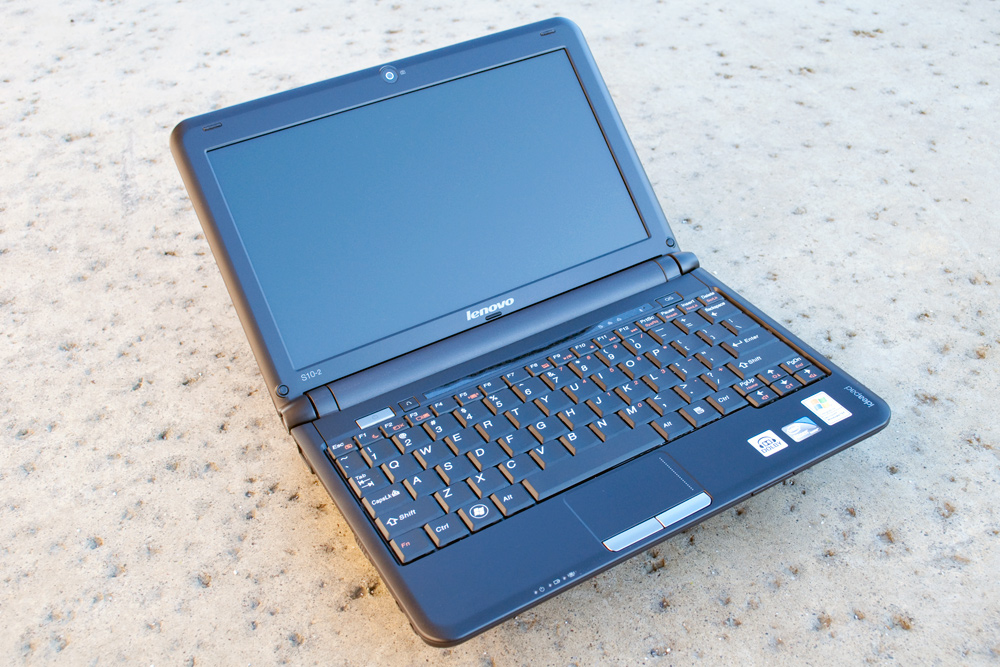
For the most part, weight is evenly distributed throughout the body. Unfortunately, the 6-cell battery offsets the balance towards the back of the unit. I generally despise any unit that has an accessory that departs from the general aesthetics and style of a gadget. Fortunately the 6-cell battery isn’t required, but rather is an upgrade from the 3-cell that sits flush with the casing. The extended battery also raises the netbook at an angle making it appealing for typing on a desk, however it ends up causing discomfort when on your lap. Plus, the bulging battery is always an awkward fit in backpacks, cases, or sleeves.
I generally would complain about the glossy finish since it’s a fingerprint nightmare, however that’s the trend just about every gadget manufacturer has taken. The chassis of the IdeaPad S10-2 is quite robust. It’s definitely heavier than the Dell Mini 9, but seems stronger and definitely won’t warp under pressure. I found the “feet” on the bottom and sides of the netbook a bit obtrusive and rugged. With some tweaks, the IdeaPad could have been as clean of a design as the Dell Mini 9. I was also glad that Lenovo kindly offers easy-access to replace or upgrade hardware components such as the RAM and Hard Drive which are hidden under two screwed in panels on the bottom. Overall, it’s a great layout and from what I’ve seen at the Consumer Electronics Show earlier this month, the IdeaPad S10-3 only gets better.
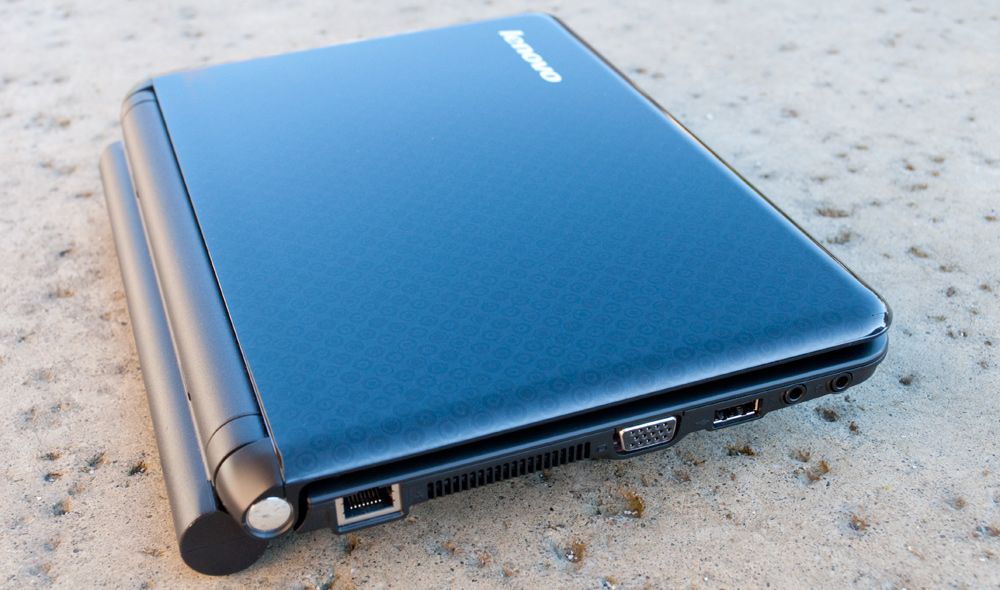
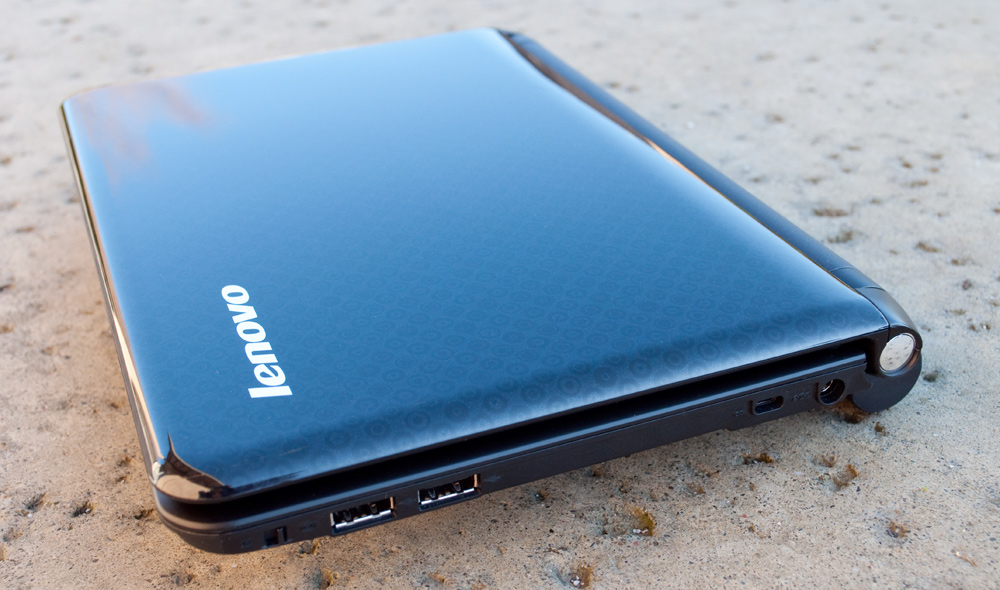
Connectivity – 5/5 stars
The S10-2 netbook offers a standard set of ports that are found on most netbooks. There’s a total of three USB ports: one on the left and two on the right side. That’s a great idea to prevent too many cables from cluttering a single side. Ethernet and VGA connectors are on the left side along with a line in for microphones and line out for headphones. On the front there are some standard LED indicators and a 4-in-1 reader that supports cards including Secure Digital (SD) and Memory Stick (MS). The AC power connector, Kensington lock, and WiFi switch are on the right side. The IdeaPad is completely on par with most netbooks on the market, there aren’t any extras or anything missing.
Keyboard & Touchpad – 2.5/5 stars
I wasn’t exactly too impressed with the keyboard and touchpad. While it’s expected that a smaller body requires reducing the size of keys, there are some issues that are worth mentioning. Lenovo decided to take a regular keyboard and shrink it proportionally until it fits on this 10-inch netbook’s body. This makes typing especially difficult for those coming from a regular keyboard and for those with large hands. I should also mention that Lenovo laptop keyboards interchange the “Fn” and “Ctrl” keys, which may take some getting used for those who aren’t familiar with their ThinkPad products. (You can apparently tweak that setting in the BIOS to switch the functionality.)
Dell, for example, tried to keep the keys as large as possible on the Dell Mini 9, but ended up running out of space and removing the entire function key row. That was a diaster for Dell, but they fortunately took a fresh approach on the new Mini 10 netbook with a keyboard that runs nearly edge-to-edge with the frame. Lenovo seems to have struggled on this S10-2 netbook, but has cleaned up their act on the new S10-3 model which features a 98% full-size keyboard. Other than those layout quirks, the keyboard does offer a quality feel and it’s still comfortable to use once you figure out where the keys are. There’s a decent amount of tactile force feedback which is an important aspect of a great typing experience.
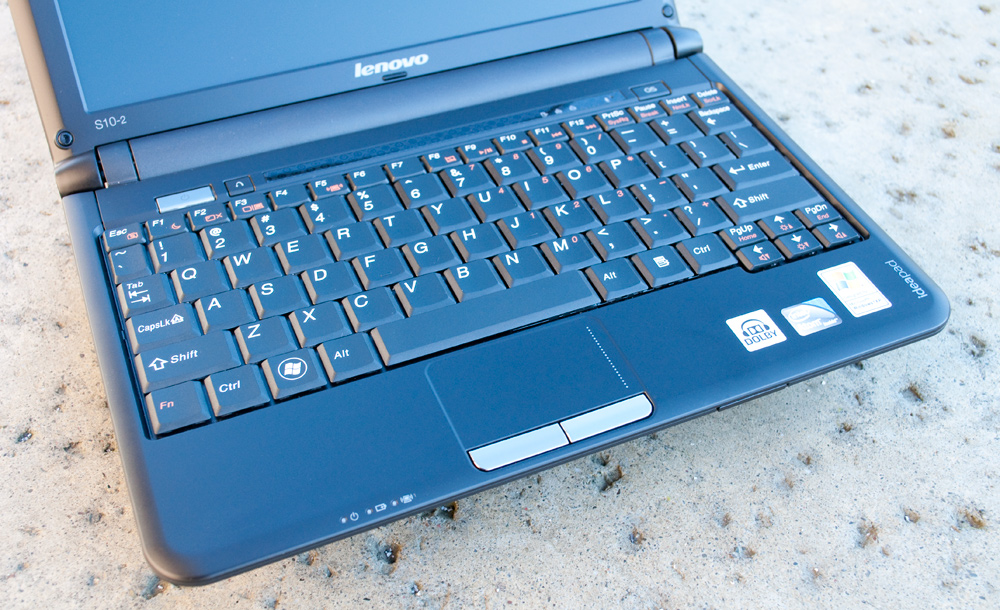
I am also disappointed to say that I found myself frustrated with the touchpad. Even I’m aware that this is a small device, the touchpad simply seems too small. Even the Dell Mini 9, which has a frame that’s an inch smaller than the IdeaPad S10-2, sports a larger touchpad. I often felt constrained and ran into the small raised border surrounding the touchpad when making quick movements. There’s support for the pinch multi-touch gesture to zoom in or out, which is an appreciated addition. The dedicated scroll region unfortunately limits the area available for regular movements even further. Implementing a two finger scroll could potentially have saved some space. The left and right-click keys were thankfully the best part of the touchpad area. They offer a nice quick click for feedback when pressed. Both the keys are large enough for regular use and are easily accessible. Lenovo should have allocated more space for the touchpad as they have with the new IdeaPad S10-3.
Display – 3/5 stars
The display on the IdeaPad S10-2 isn’t too extraordinary. It’s an average 10.1 inch glossy screen with LED back-lighting running at a 1024 x 600 resolution. There’s nothing that truly sets it apart from other netbook screens. The display is recessed into the casing with a thick surrounding bezel. Most new laptops and netbooks manufacturers are opting for the cleaner look of an edge-to-edge display with a single piece of glass. Although this display is glossy, it isn’t too difficult to use in bright rooms, but will almost always look dull under direct sunlight. The blacks are also brought out further due to the glossy screen. If you look closely, the grid-line appearance of the pixel arrangement is more noticeable than on other displays. The viewing angles are not a problem if the IdePad is on your lap or on a table directly in front of you. However, the colors quickly begin to deteriorate if the screen is tilted forwards or backwards. Fortunately, horizontal viewing angles are good enough to accommodate a person sitting besides you.
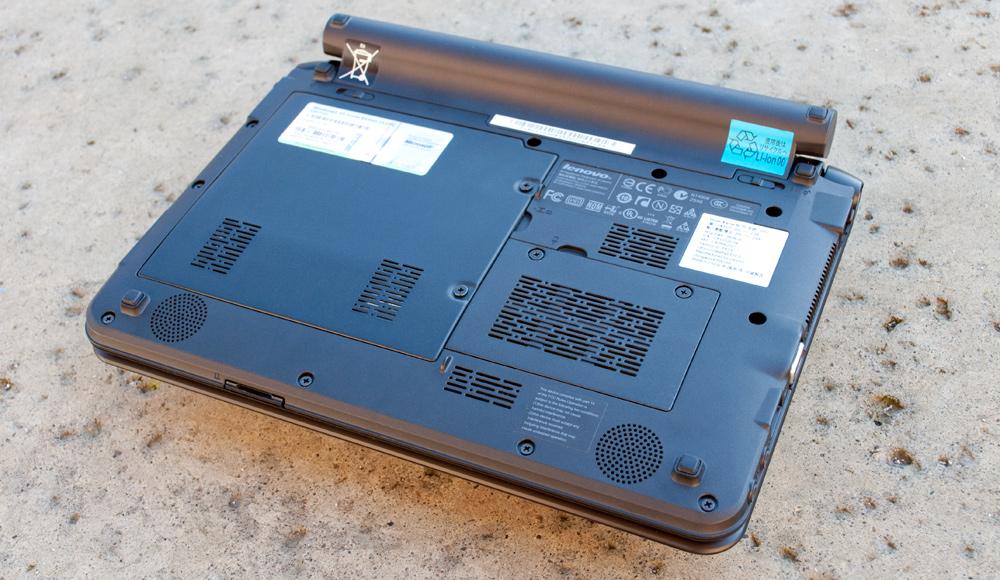
Speakers – 2.5/5 stars
As with most netbooks which are tight on space, the speakers on the IdeaPad are into a poor location. Instead of facing the user, the speakers are currently pointing downwards. Everything sounds muffled if the netbook is on your lap, on a bed, or a sofa. However, it wasn’t much of a problem if it’s on a desk since the netbook’s “feet” create enough of a gap. But the speakers could have definitely been outfitted in a better location. There’s nothing spectacular about the audio quality and the midrange is mediocre, but it’s not a problem for enjoying Hulu, YouTube, and other web video content. They get loud enough and get the job done. The audio card is decent and if you plugin a decent pair of headphones, everything sounds vastly better. Plus, you won’t be disturbing others either.
Webcam & Microphone – 3/5 stars
There’s no better way to put a webcam and microphone to the test without using Skype. I opted to use the 4.2 beta version that supports HD-like video quality. Although this laptop only has an underpowered .3 megapixel resolution camera, I hoped to stream some quality video. Unfortunately, I found myself quite disappointed with the quality. Images were dark, grainy, and pixelated even in a bright room. It’s definitely a problem if you can’t make out a face easily. After using this, I couldn’t possibly appreciate that improvements a decent 1.3 megapixel camera offers more. As for the microphone, it was actually fairly clear for conversations. If you want a better microphone, you can always plugin either a USB microphone or an analog one into the line-in port. But for the most part, the microphone will do just fine for having a voice conversation with someone from a quiet office setting.
The IdeaPad S10-2 also came with a VeriFace facial recognition login security software. I programmed it to myself to give it a run. Although I had never tried it, I was quite impressed with the convince factor. Just sit in front of the laptop and it jumps past the Windows XP sign-on screen in just a few seconds. To test it further, I had a few friends try their faces in place of mine. I’m Indian and I was glad to see that the software immediately dismissed all three friends who were Vietnamese, Palestinian, and Caucasian respectively. I then had another Indian friend try logging in and after a few failed attempts, it randomly decided to let him in. We attempted to reproduce the occurrence, but weren’t able to do so. While VeriFace was convenient, I don’t know all the details on the platform’s security precautions and I feel we should probably give this technology some more time in the oven.
Operating System – 3/5 stars
When the IdeaPad S10-2 came in from Lenovo, it furnished a bloated version of Windows XP Home. There were nearly 55 processes running and it was a mess. Some of these apps included an older version of Symantec Anti-Virus, a trial version of Microsoft Office, MSN Messenger, some browser toolbars, and a few often unused Adobe programs. A clean install of the same operating system on a netbook generally has about 30 processes running at startup with drivers and essential programs installed. For an experiment, I opted to install Windows 7 Professional for further tests. It installed surprisingly quickly and worked seamlessly. Just about all the drivers were automatically configured. Although the Windows Index Rating was a minimal 2.0, it still managed to run Aero for translucency and effects. Surprisingly, even Windows Media Center 7 ran fairly well. The largest downside of Windows 7 is RAM consumption, nearly using twice as much as XP, there’s not much left over for programs. I would highly recommend stripping out the 1GB dimm and upgrading to 2GB if you want to run Windows 7. For the most part, Windows XP still works great for netbooks and should be able to accommodate the average user’s needs. Although manufacturers are loading Windows 7 Starter on new netbooks, I would have been happy to use XP on this netbook if it weren’t filled with nearly as much bloatware. Lenovo should consider the toll bloatware takes on a netbook’s performance and battery life.
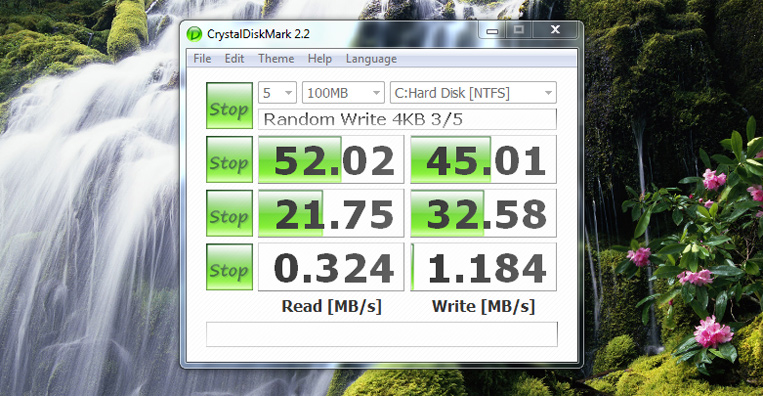
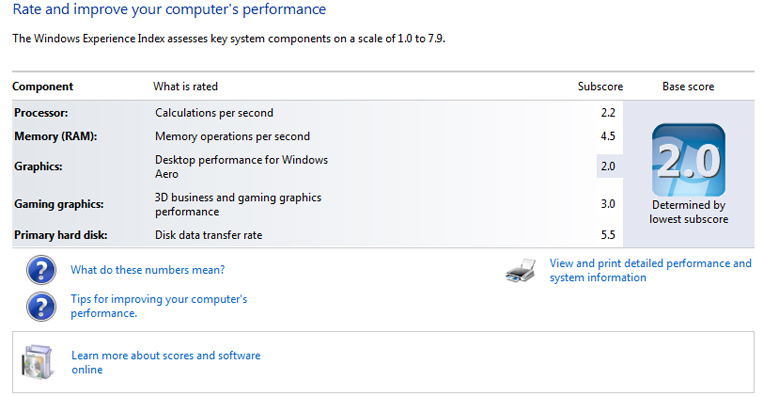
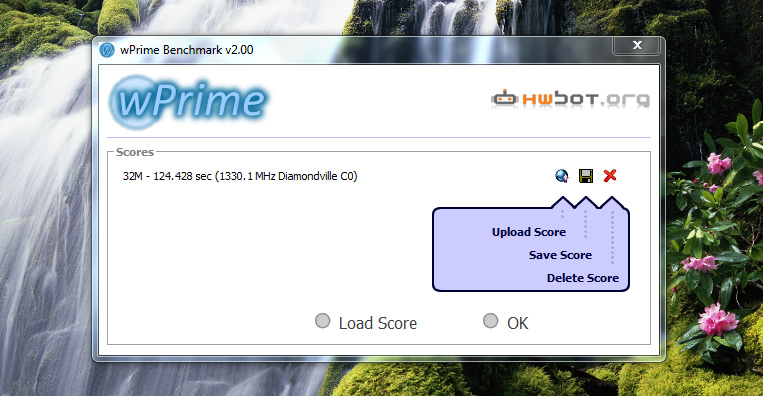
Performance – 4/5 stars
The IdeaPad S10-2 performs on par with most netbooks on the market. The lack of a SSD might make it take slightly longer for startup or shutdown, but it was still faster at both than my Dell XPS M1530. The laptop recovers from standby in just a second or two at max. Firefox played fairly well, but would often freeze up while the CPU catches up if I had too many tabs open. The currently stable version of Adobe Flash doesn’t have GPU acceleration so 480p Hulu videos were often hard for the netbook to digest. It would begin to jitter for a few seconds every few minutes. Although programs like VLC were able to handle playing large video files smoothly, the laptop really can’t handle Full HD 1080p content yet. However this netbook works great for word processing, web browsing, and a lightweight entertainment.
In terms of raw performance, the Atom N270 processor performed on par with just about all the other netbooks we’ve tested using the same CPU. See the image above for numbers. To my surprise, the 160GB 5400RPM hard drive was faster than the 200GB 7200RPM one in my Dell XPS M1530, so no complains there. The device did begin to get somewhat warm near the HDD when stressing it with resource intensive applications, however wasn’t anywhere close to being unbearable. That fan is to take credit for that and thankfully it was fairly silent as well. Some netbooks I’ve tested have gotten awful warm and become difficult to hold.
Battery Life – 5/5 stars
I was quite impressed with how long this laptop would keep running for. With Windows 7, I achieved a little over 6 hours with brightness lowered to about 25%, volume off, and WiFi on. I spend most of the time typing documents and browsing the web. I also achieved close to the same amount when I took this along with me to the Consumer Electronics Show to live-blog a few press conference using a Sprint 4G USB modem. I should mention that the original operating system, Windows XP, offered even more efficiency clocking in at 7 hours. In contrast, my Dell Mini 9 with a 4-cell battery only offers about 4 hours of battery life. If you plan to watch a CPU intensive flash video on Hulu or heavily multitask, the 6-7 hour run-time is not realistic. But for the most part, the 6-cell 47WHr battery is quite impressive. As the next generation of netbooks are beginning to reach the 10 hour mark, I couldn’t be more excited. However, I’m still turned off by the fact that this battery obtrudes from the shape and design of the IdeaPad S10-2.
Bottom Line
A netbook is by no means a replacement to a full computer. The IdeaPad S10-2 is a great complement for students to take notes in class, for business users to take on trips, and for young children to play around. I was quite satisfied with the style, durability, and quality of this netbook. With a superb battery life, you won’t be disappointed or looking for an outlet on those long commutes or trips. While the extended battery is a bit obtrusive, the benefits of the added run time outweigh the bulk. I was upset to find excessive bloatware and would highly recommend performing a clean install with the latest drivers and programs. The IdeaPad S10-2 price starts at just $330 through Lenovo.com and the specific configuration we reviewed is available for $300 on Amazon. The laptop is available in a few colors: Grey, Black, White, Pink and designer covers. Upgrades including a boost to Windows 7 Starter, a slightly faster CPU, Bluetooth, and a few other features are available. When it comes down to it, if you need a laptop that’s compact, affordable, and durable, you won’t go wrong with Lenovo’s IdeaPad S10-2.
Buy: IdeaPad S10-2 Netbook
Links: Lenovo.com IdeaPad S10-2